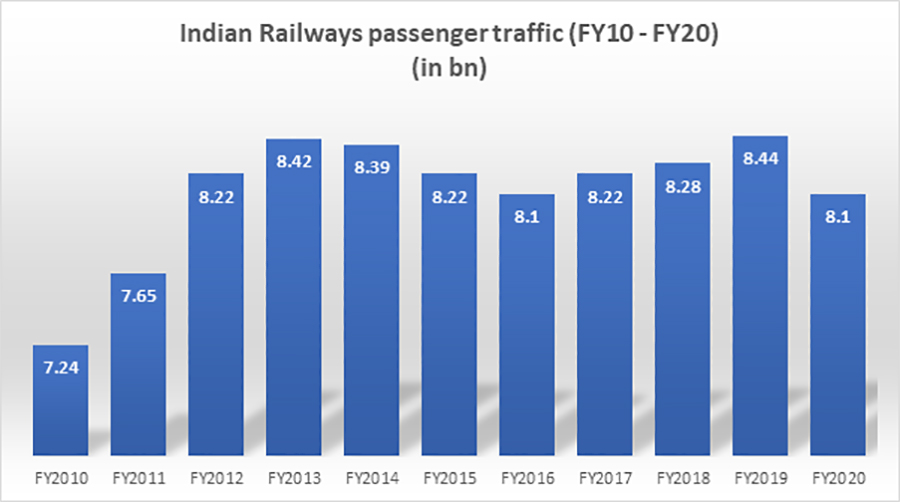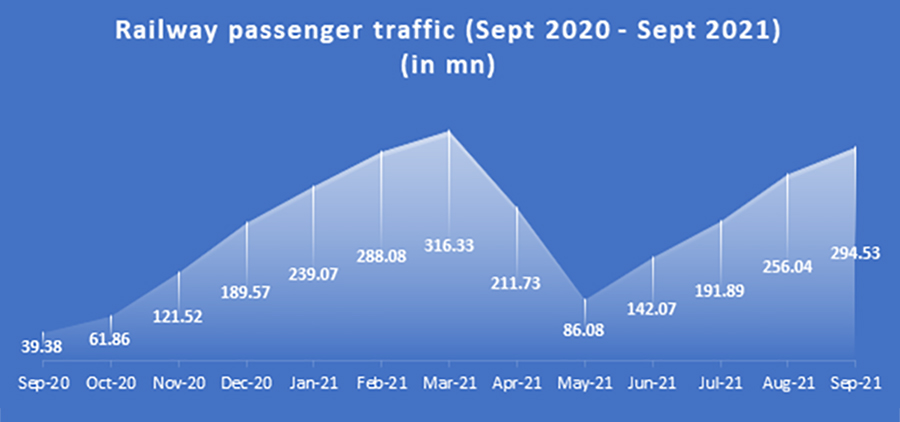Indian Railways passenger traffic volume that hovered at over 8 billion a year in the period FY2012 to FY2020, as illustrated in Figure 1, descended to the lowest ever after the Covid-19 outbreak in the country that caused the Ministry of Railways to suspend regular passenger train operations. The annual passenger volume had reached the highest level in FY2019 at 8.44 billion, which was a huge talking point for the railway advertising media companies that had forayed into this space in a big way, especially in areas like railway display network (RDN) projects that also involved significant investments in digital OOH (DOOH) assets.
Figure 1

Source: Statista
The Covid-19 pandemic threw the spanner in the wheels for the railway advertising firms with audience sizes falling drastically. Figure 2 illustrates the gyrating pattern of passenger volumes month-on-month, from September 2020 to September 2021. The data shows that as the Covid-19 case load reduced after the initial outbreak, the passenger volume increased, to reach a high of 316.33 million in March 2021, which was followed by a rapid slump as the second wave of the pandemic swept across the country. Since May 2021, the passenger volume has been increasing month-on-month to reach 994.53 million in September 2021. The current Covid-19 case load suggests that the railway passenger movement will improve significantly in the coming months.
Figure 2

Source: www.ceicdata.com
Indian Railways has meanwhile initiated big steps to modernise the train operations and station infrastructure. As a case in point, Indian Railways is planning to build 75 indigenously designed, semi-high speed Vande Bharat trains by August 2023. Prime Minister Narendra Modi had said in his address to the nation on the Independence Day this year that 75 Vande Bharat trains will connect every corner of the country.
The introduction of such trains will bring a new class of passengers to the railway networks, that will provide an impetus to railway advertising business. Currently, Vande Bharat trains are running between Delhi and Varanasi and Delhi and Katra (Jammu and Kashmir).
About these trains, Railway Minister Ashwini Vaishnaw was quoted in the media as saying they are best suited for a distance of about 500 km. “We plan to connect 300 towns and cities with the first 75 Vande Bharat trains,” he said.
The plan to introduce 150 private trains was another way to modernise the train operations. Tenders were floated for the same. However, the move did not yield great results as the interested private companies sought several changes to the norms. For instance, they wanted a shorter concession period — 18 years, as coaches usually go for mid-term retrofitting after that period, and not 35 years as mentioned in the bidding document.
However, multi-pronged initiatives to upgrade railway trains and facilities will have a positive cascading effect on the composition of audiences for railway advertising. The Udhampur – Srinagar – Baramulla rail line project merits a special mention in this regard. So far, 80% of the work on the ambitious Udhampur-Srinagar-Baramulla rail link has been completed while the rest of the work will be completed by the year 2023, said Union Minister Darshana Jardosh in a statement to the media. This rail link project has been cited as the most ambitious railway project in the country post-Independence.
Station re-development
A few years ago, the Indian Railway Station Re-Development Corporation (IRSDC) had been entrusted the role of revamping railway stations and also developing greenfield stations. As part of the station re-development plans, the Ministry of Railways is revamping New Delhi railway station to give it a look and feel of world-class airports. Citing that around 4.5 lakh people visit the New Delhi station every day, the ministry has said there is a need for the station to be equipped with world-class amenities.
The New Delhi railway station, once developed, will have a 40-storey twin tower, multi-level car parking, pick up and drop zones. The twin tower will house offices, retail shops and will also have space for a hotel. Further, 91 bus bays, 1,500 ECS parking, skywalks for pedestrians and metro passengers will be developed on site.
Likewise, Bengaluru city’s Yesvantpur station has been given a major makeover. The railway station has been equipped with multiple upgraded facilities. Also, roofing and landscaping has been done in front of the railway station building and the common parking areas. Besides, cab and auto stands have been upgraded as well with wider approach roads.
The development work on the third terminal with seven platforms in Bengaluru at Baiyappanahalli is almost over. The station has been designed to serve one lakh railway passengers’ footfall on a daily basis.
This way, stations wil be transformed into Railopolis – an integrated mini smart city to work, play and ride.
Elsewhere, the railway station in Odisha’s capital Bhubaneswar will be developed into a world-class facility. Currently, a joint plan is being prepared with Bhubaneswar Development Authority (BDA) to make the station redevelopment project a success.
Tourism
Indian Railways is also taking steps to give a boost to tourism leasing, selling coaches to private parties. In a bid to tap the countries tourism potential as well as to leverage the core strengths of the professionals of the sector in tourism activities such as hospitality, marketing, reach with customer base, integration of services, expertise in development and identification of tourist circuits, etc., Railways is planning to promote railway based tourism among masses through leasing of coaching stock to interested parties. With this, interested private companies could be able to run these trains as theme based religious, cultural and other tourist circuit train services.
Railways has also come up with rail coach restaurants. The West Central Railways was the first to hop on this wagon and released five-year contracts under the non-far revenue (NFR) policy. The NFR policy ensures that the Railways is adding bulk to their income through various sources other than freight and passenger receipts.
On another front, Railways has introduced 'Vistadome' coaches on two of its routes on Mumbai -Pune and Bengaluru-Mangaluru sections. The railways are planning to introduce these on other routes as well which includes the northeastern parts of the country as well.
IRSDC has announced that it has invited bis for establishing and maintaining a Rail Arcade at Krantiveera Sangolli Rayanna and Chandigarh railway stations for a duration of nine years. The Rail Arcade has been envisaged as as a mini-city centre with various facilities including food and beverage, leisure, entertainment as well as retail.
Improved train services, modernisation of trains and stations, and promotion of modern retail and entertainment centres at stations, will also contribute to a huge makeover of railway passenger profiles. As the passenger traffic volumes get back to pre-Covid levels, railway media will once become much-sought after investment destinations.


_525_860.jpg)